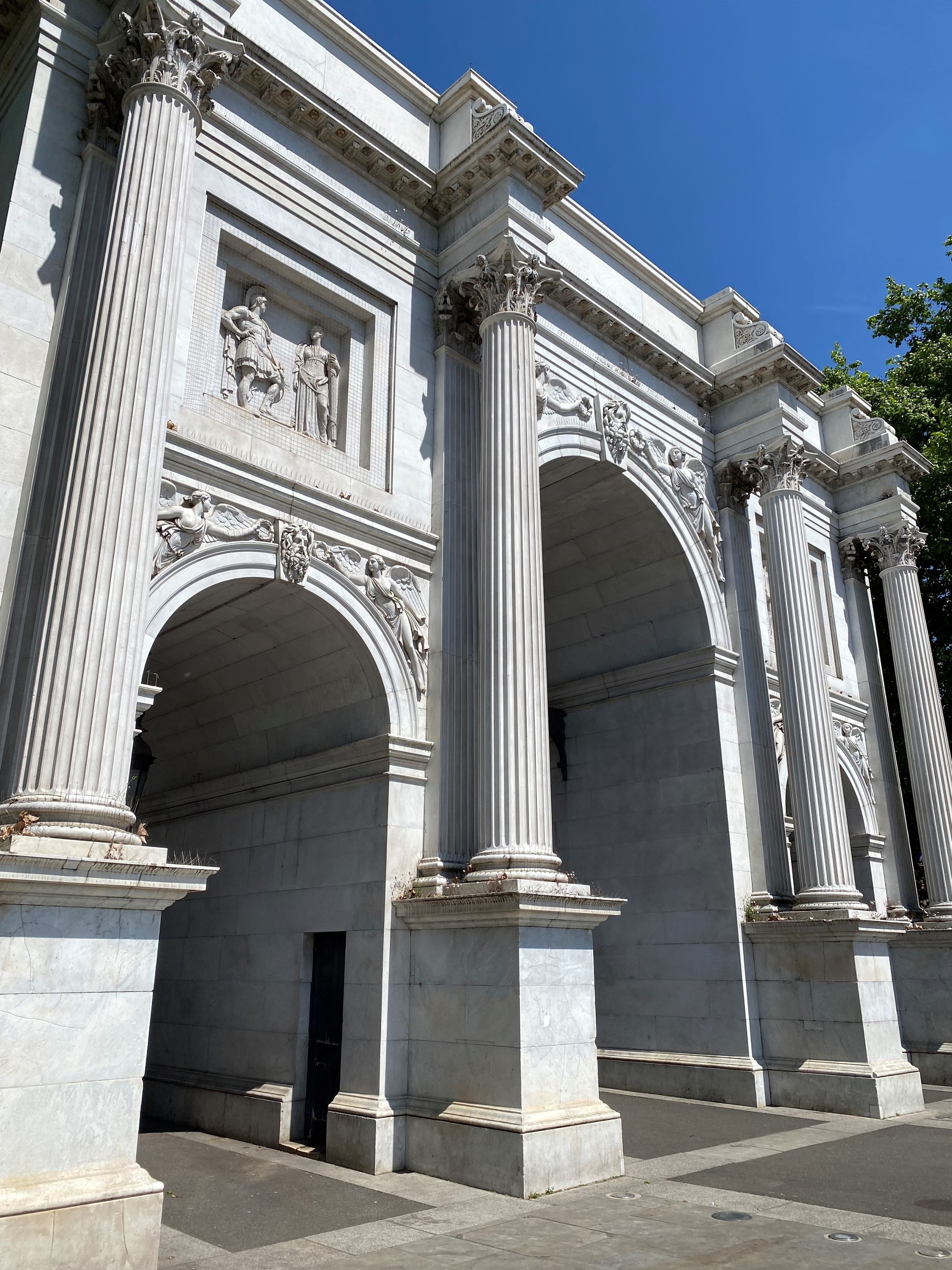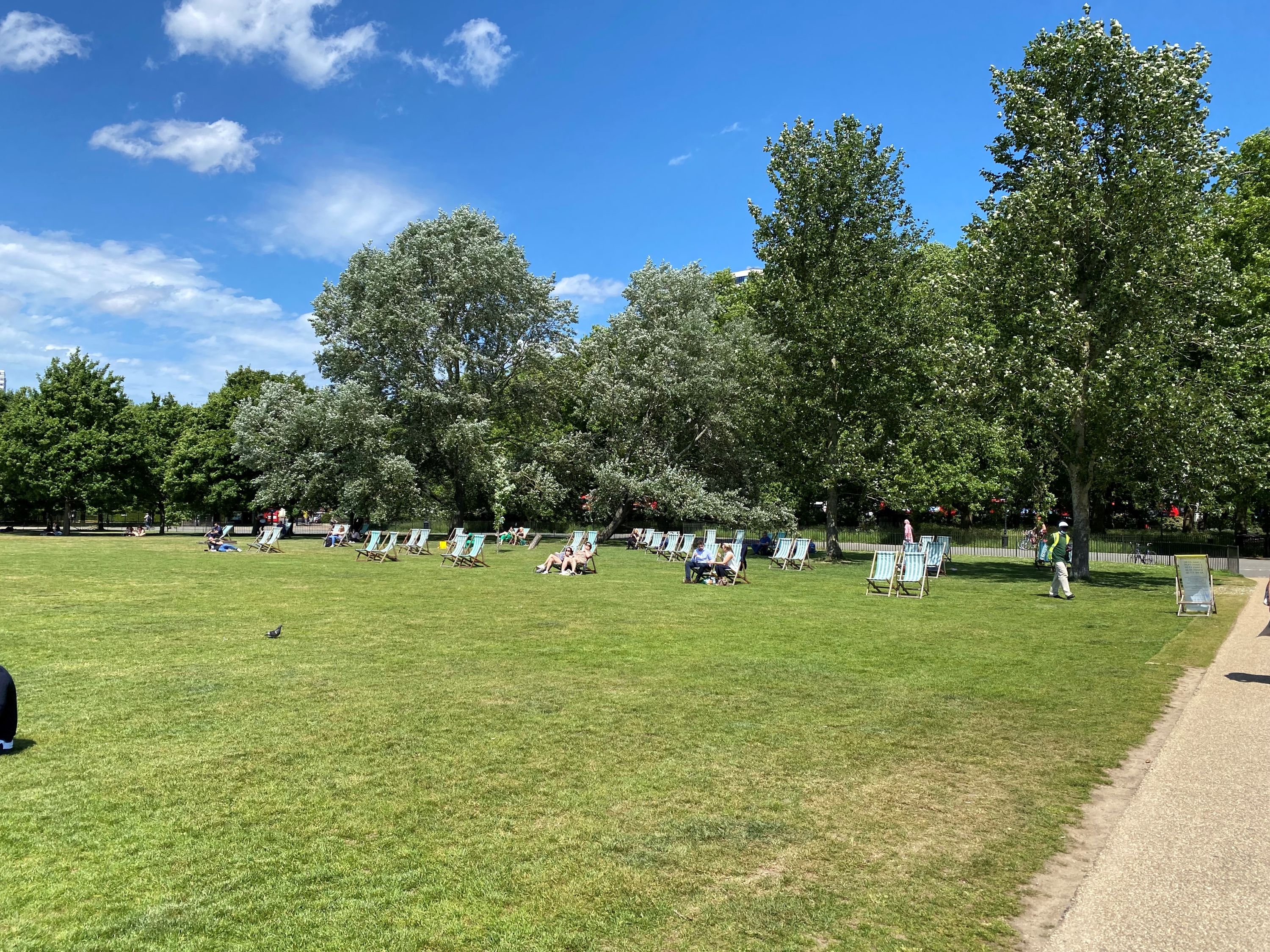21 Jun 2022
Today, the Royal Parks cover 5,000 acres of London and are vital refuges for wildlife with more than 4,000 species of invertebrates and 100 species of birds recorded in them. There are also a huge number of mammals including hedgehogs, pipistrelle bats, together with free-roaming deer. These glorious spaces welcome tens of millions of human visitors each year using the pathways to visit London’s iconic sights and, during the Spring and Summer months, to relax in the sun.
Marble Arch is a 19th Century white marble faced triumphal arch with the structure designed by John Nash in 1827, originally planned to be the State entrance for Buckingham Palace. In 1851, on the initiative of the architect and urban planner, Decimus Burton, it was relocated to its current site. The design is based on that of the Arch of Constantine in Rome and the Arc de Triomphe du Carrousel in Paris. There are three rooms within the arch which were used as a police station from 1851 until at least 1968. The Arch was built as an exuberant celebration of British victories in the Napoleonic Wars. The hero of these wars, the Duke of Wellington, is best remembered for his defeat of Napoleon Bonaparte at Waterloo and there are many memorials to his success on the battlefield throughout London including at Hyde Park Corner.

During my visit to London in May I caught up with Mike Riddell who manages the Allianz Strategic Bond Fund which, at the time of the meeting, had endured a difficult six months, as central banks globally had reacted to rising inflation by increasing interest rates. Despite rising rates, Mike had a relatively sanguine outlook for certain areas of the bond market, especially after the sharp selloff at the start of 2022. He believes the pickup in inflation has been driven by factors such as the rise in energy costs rather than a move to structurally high inflation over the longer term. Since the summer of 2020, the fund had mitigated its interest rate exposure through short duration positioning, but after the rapid rise in bond yields in 2022, Mike argues that some government fixed interest markets are looking cheap.

The team at Allianz now believe a recession is the central case rather than just a mid-cycle slowdown and consequently they prefer government debt over corporate credit. Within the non-government part of the portfolio, there is a preference for emerging market local currency debt, where positive real (after inflation) yields are available since central banks in many of these countries have pre-emptively tightened policy ahead of developed markets. On the currency front, the fund has benefited from a long position in the US$. Mike argues that high commodity prices impact on growth with a six-month lag, so is a believer in a relatively significant economic slowdown. With the team’s base case recession, the fund has been selectively adding developed market duration in areas where rate hikes at the short end are already priced in and tougher monetary policy today will result in expectations of rate cuts a few years out as economies slow and inflation falls. Favoured areas are the US, Canada, Australia, and Korea.
While most bond funds focus on fixed interest securities, an alternative option for investors is floating rate debt which provides protection against rising interest rates that aren’t present in traditional bond portfolios. The M&G Global Floating Rate High Yield Fund invests globally across the FRN market and has been managed by James Tomlins since its launch. The fund relies primarily on a bottom-up bond selection process with a top-down overlay and while unconstrained by its benchmark index, is always well diversified at the issuer level. The fund aims to maximise total return looking at a combination of income and capital and coupons are reset every three months in line with short-term interest rates such as LIBOR or the overseas equivalent. FRNs also have a fixed spread - the difference in yield between risk-free government bonds and the credit issued by companies - but with zero interest rate duration the fund has low sensitivity to changes in interest rates, whether they move up or down. The risk in the fund in the short-term is if spread widening occurs in credit markets, and in the longer-term if there are defaults, but in a rising rate environment, investors benefit from a higher income. The fund is looking to give senior loan performance, traditionally unavailable to retail investors, combined with daily liquidity.

Fund manager James Tomlins has a relatively confident big picture view of the world. He does not believe that the global economy will enter into such a severe downturn that it leads to a significant increase in defaults in the credit markets.
The fund offers investors a differentiated play in the bond universe and the credit quality compared to traditional high yield funds is much higher as around three-quarters of the portfolio is held in senior secured bonds where recovery rates in the case of defaults have historically been not far below 100% due to their much higher place in the capital structure. The experience of the manager in this area of the bond market, combined with the strength of the credit research team at M&G who assess all individual holdings, make it an interesting satellite addition to investor portfolios, especially for those not wanting exposure to interest rate risk and wanting a relatively high level of yield.
Walking back to the hotel after a day of meetings there were a surprising number of green oases in the form of leafy squares in Central London, many of which have a notable history. For example, St. James Square, was planned in the mid-17th Century by the Earl of St. Albans who conceived the original layout and was granted a freehold by the crown in 1665 to build 12-13; ‘Great and good houses, fitt for ye dwellings of Noble men and other Persons of Quality’. This was subsequently enlarged to 23 houses and during the 1670s the square took shape. At the centre of the square is a statue of King William III designed by John Bacon, executed in bronze by his son and erected in 1808. Since then, the garden’s main design has changed very little, although pathways have been re-routed and trees and plant beds both introduced and removed. Over the years, the houses have included as residents: Monarchs, foreign ambassadors, and no less than 15 Prime Ministers, and in the background to the left of the statue is Chatham House where Prime Ministers Lord Chatham, William Pitt, and W.E. Gladstone formerly lived.

Graham O'Neill, Senior Investment Consultant, RSMR
This information is for UK Professional Advisers only and should not be given to retail clients.
The value of investments and the income from them may go down as well as up and investors may not get back the amounts originally invested.
Rayner Spencer Mills Research Limited is a limited company registered in England and Wales under Company Registration Number 5227656. Registered office: Number 20, Ryefield Business Park, Belton Road, Silsden, BD20 0EE. RSMR is a registered trademark.